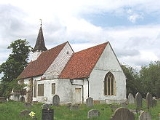
St Mary the Virgin, Northolt
Encyclopedia
St Mary the Virgin is a 13th century Anglican parish church
in Northolt
, London
. Located on Ealing Road, it stands on a slope that originally overlooked the old village of Northolt and is situated adjacent to the site of a 15th century manor house. It is one of London's smallest churches, with a nave measuring only 44 feet (13.4 m) by 25 feet (7.6 m). The church was built around 1290 and was expanded over the following centuries, with the chancel
being added in 1521, the spired bell tower
being added in the 16th century and a gallery being built at the west end of the church in 1703. Twin buttresses were erected against the west wall around 1718 to alleviate concerns that the church could slip down the hill. The internal beams are original and the bells date from the 17th century. The church was constructed from a variety of materials; the nave incorporates clunch
(a type of limestone), flint
and ironstone
, and the mouldings of the doors and windows are made from Reigate stone.
Despite its small size, the church has played an important role in the ecclesiastical life of London; from the 13th century to 1873 its Rector
served as the Bishop of London
. It was the first Anglican parish to appoint a female Rector, the Reverend Pamela Walker.
Parish church
A parish church , in Christianity, is the church which acts as the religious centre of a parish, the basic administrative unit of episcopal churches....
in Northolt
Northolt
Northolt is a town in the London Borough of Ealing, England. The town has London Underground and Network Rail stations and is on the A40 road...
, London
London
London is the capital city of :England and the :United Kingdom, the largest metropolitan area in the United Kingdom, and the largest urban zone in the European Union by most measures. Located on the River Thames, London has been a major settlement for two millennia, its history going back to its...
. Located on Ealing Road, it stands on a slope that originally overlooked the old village of Northolt and is situated adjacent to the site of a 15th century manor house. It is one of London's smallest churches, with a nave measuring only 44 feet (13.4 m) by 25 feet (7.6 m). The church was built around 1290 and was expanded over the following centuries, with the chancel
Chancel
In church architecture, the chancel is the space around the altar in the sanctuary at the liturgical east end of a traditional Christian church building...
being added in 1521, the spired bell tower
Bell tower
A bell tower is a tower which contains one or more bells, or which is designed to hold bells, even if it has none. In the European tradition, such a tower most commonly serves as part of a church and contains church bells. When attached to a city hall or other civic building, especially in...
being added in the 16th century and a gallery being built at the west end of the church in 1703. Twin buttresses were erected against the west wall around 1718 to alleviate concerns that the church could slip down the hill. The internal beams are original and the bells date from the 17th century. The church was constructed from a variety of materials; the nave incorporates clunch
Clunch
Clunch is a term for traditional building material used mainly in eastern England and Normandy. It is a term which encompasses a wide variety of materials, often locally variable....
(a type of limestone), flint
Flint
Flint is a hard, sedimentary cryptocrystalline form of the mineral quartz, categorized as a variety of chert. It occurs chiefly as nodules and masses in sedimentary rocks, such as chalks and limestones. Inside the nodule, flint is usually dark grey, black, green, white, or brown in colour, and...
and ironstone
Ironstone
Ironstone is a sedimentary rock, either deposited directly as a ferruginous sediment or created by chemical repacement, that contains a substantial proportion of an iron compound from which iron either can be or once was smelted commercially. This term is customarily restricted to hard coarsely...
, and the mouldings of the doors and windows are made from Reigate stone.
Despite its small size, the church has played an important role in the ecclesiastical life of London; from the 13th century to 1873 its Rector
Rector
The word rector has a number of different meanings; it is widely used to refer to an academic, religious or political administrator...
served as the Bishop of London
Bishop of London
The Bishop of London is the ordinary of the Church of England Diocese of London in the Province of Canterbury.The diocese covers 458 km² of 17 boroughs of Greater London north of the River Thames and a small part of the County of Surrey...
. It was the first Anglican parish to appoint a female Rector, the Reverend Pamela Walker.

